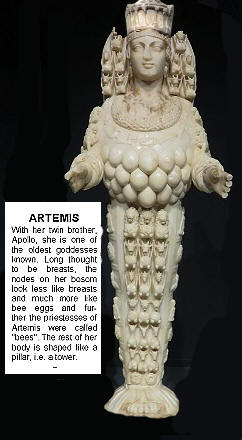However, there is nothing in the Gospels to support the
idea that Mary Magdalene was ever a prositute - Nothing!!
Why
have all the Christian writers since the first century
misrepresented the person we call Mary Magdalene?
Clearly, they are discrediting her for the same reason a lawyer
discredits the character of a witness - to dismiss her role in the
Gospels!!
The True Mary Magdalene
The true identify of Mary Magdalene has been deeply buried, but
there are some things we do know for sure.
Mary is a traditional Jewish name (Mariam), possibly of Egyptian
origin. Magdalene, in the Hebrew original, means “from the
tower(Migdal)”; referring either to Magdala, a thriving fishing town
on the coast of Galilee and
within walking distance of Capernaum, where Jesus started of
his ministry. Or it may be a reference to a tower (symbolic or
not) with which she is associated. Luke 8:2
says that Jesus casting demons from Mary Magdalene, sometime
prior to her becoming his committed follower.
in three of the four canonical Gospels, Mary Magdalene is mentioned by name only in connection with the death and resurrection of Jesus. She is a witness to his crucifixion (Matthew 27:55–56; Mark 15:40–41; John 19:25) and burial (Matthew 27:61; Mark 15:47).1 She is one of the first (the first, according to John) to arrive at the empty

tomb (Matthew
28:1–8; Mark 16:1–8; Luke 24:1–12; John 20:1–10). And she is one of
the first (again, the first, according to John) to witness the risen
Christ (Matthew 28:9; John 20:14–18).
We learn that Mary Magdalene experienced a positive change in her
life due to her meeting Jesus. The traditionalists, due to their
obsession with sex, claim that she was originally a prostitute. Have
we allowed the chauvinism of the past to influence our modern
understanding? Is it
not equally possible that the change was not sexual, but religious?
Could it be that the “evil” that Jesus removed from her, was not
prostitution, but her
participation in an unpopular religious activity?
Why put down Mary Magdalene?
According to Harvard scholar Karen King, a tiny papyrus fragment, smaller than a business card, ignites the controversy about whether or not Jesus had a spouse. In the newly publicized fourth century fragment, Jesus supposedly refers to her as, “my wife.” Just below that phrase, the papyrus includes a second provocative clause that purportedly says, “she will be able to be my disciple.”
Dr. King
first learned about what she calls
The Gospel of Jesus’ Wife’
in 2010 when a private collector asked her to translate it. Dr.
King, specializes in Coptic literature, and has written several
books on Coptic-Christian subjects.
There are numerous writings on the marriage of Jesus, but we
will not go into that here (Google
Jesus married
) Denial of the marriage of Jesus is certainly one reason for the
early Christians to denigrate Mary Magdalene, but could there be
another reason.
Gospel of Philip "There were three who always walked with the Lord: Mary, his mother, and her sister, and Magdalene, the one who was called his companion. . . . .And he loved her more than all the disciples and used to kiss her often on her mouth. The rest of the disciples They said to him, "Why do you love her more than all of us?" The Savior answered and said to them, "Why do I not love you like her? When a blind man and one who sees are both together in the darkness, they are no different from one another. When the light comes, then he who sees will see the light, and he who is blind will remain in darkness"
Gospel of Thomas Simon Peter says to them: "Let Mary go out from our midst, for women are not worthy of life!" Jesus says: "See, I will draw her so as to make her male so that she also may become a living spirit like you males. For every woman who has become male will enter the Kingdom of heaven."
The Lost
Gospel (The
Story of Joseph and Aseneth)
This is the most controversial, and obscure text of them all.
It dates prior to the 6th century AD - though this is the oldest
copy available. Superfically it narrates
the romance, and marriage of the Israelite patriarch Joseph
and his Egyptian wife, Asenath.
(Genesis 41:45)
Some regard it as nothing more than an Jewish elaboration on the story.
Others question its Jewish origin because of its language
(Son of God, Bride of God) and the Eucharistic symbolism Many argue
that the text is Gnostic Christian in origin and is the veiled story of the
marriage of Jesus and Mary Magdalene.
Jesus cast out demons from Mary Magdalene and
seeing Joseph caused Asenath to forsake her Pagan gods. In the
narration Joseph is called the Son of God and is described in terms
reserved for Christ or God. The obsession with virginity can only be
found in Christianity and the worship of Artemis. Artemis'
twin brother is Apollo, or Adonis which means "Lord.", Remember this
story takes place in Egypt where the marriage of brother and sister
was custom.
Going deeper, it may be, at root, the myth of the
union of Jesus and Artemis - the two major deities of the first
century AD. This union is to be found in Coptic Christianity.
Supporting this idea is the notable focus in The
Lost Gospel on the tower in which
Asenath
lived and her strange spiritual
relationship with bees. Both the tower and bees are
important symbols found in the worship of Artemis.
Asenath could represent either Artemis or Mary Magdalene. The "Lord" may be Joseph, but more than likely he is Jesus, i.e. the Lord, the Son of God